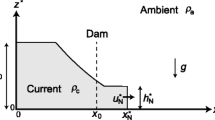Abstract
A neutral density surface is a logical study frame for water-mass mixing since water parcels spread along such a surface without doing work against buoyancy restoring force. Mesoscale eddies are believed to stir and subsequently mix predominantly along such surfaces. Because of the nonlinear nature of the equation of state of seawater, the process of accurately mapping a neutral density surface necessarily involves lateral computation from one conductivity, temperature and depth (CTD) cast to the next in a logical sequence. By contrast, the depth of a potential density surface on any CTD cast is found solely from the data on this cast. The lateral calculation procedure causes a significant inconvenience. In a previous paper by present author published in this journal (You, 2006), the mapping of neutral density surfaces with regularly gridded data such as Levitus data has been introduced. In this note, I present a new method to find the depth of a neutral density surface from a cast without having to specify an integration path in space. An appropriate reference point is required that is on the neutral density surface and thereafter the neutral density surface can be determined by using the CTD casts in any order. This method is only approximate and the likely errors can be estimated by plotting a scatter diagram of all the pressures and potential temperatures on the neutral density surfaces. The method assumes that the variations of potential temperature and pressure (with respect to the values at the reference point) on the neutral density surface are proportional. It is important to select the most appropriate reference point in order to approximately satisfy this assumption, and in practice this is found by inspecting the θ-p plot of data on the surface. This may require that the algorithm be used twice. When the straight lines on the θ-p plot, drawn from the reference point to other points on the neutral density surface, enclose an area that is external to the cluster of θ-p points of the neutral density surface, errors will occur, and these errors can be quantified from this diagram. Examples showing the use of the method are presented for each of the world’s main oceans.
Similar content being viewed by others
References
Foster, T. D., and E. C. Carmack, 1976. Frontal zone mixing and Antarctic Bottom Water formation in the southern Weddell Sea. Deep-Sea Res., 23: 301–317.
Ivers, W. D., 1975. The circulation in the northern North Atlantic, with especial reference to the Labrador Sea. Ph.D thesis, University of California, San Diego, 179pp.
McDougall, T. J., 1987a. Neutral surfaces. J. Phys. Oceanogr., 17: 1950–1964.
McDougall, T. J., 1987b. Thermobaricity, cabbeling, and water-mass conversion. J. Geophys. Res., 92: 5448–5464.
McDougall, T. J., and D. R. Jackett, 1988. On the helical nature of neutral trajectories in the ocean. Prog. Oceanogr., 20:153–183.
You, Y., and T. J. McDougall, 1990. Neutral surfaces and potential vorticity in the world’s oceans. J. Geophys. Res., 95:13235–13261.
You, Y., 2006. Review of global ocean intermediate water masses: 1. Part A, the neutral density surface (the ‘McDougall surface’) as a study frame for water-mass analysis, J. Ocean Univ. Chin., 5: 187–199.
Author information
Authors and Affiliations
Corresponding author
Rights and permissions
About this article
Cite this article
You, Y. Mapping of an approximate neutral density surface with Ungridded data. J. Ocean Univ. China 7, 1–9 (2008). https://doi.org/10.1007/s11802-008-0001-9
Received:
Accepted:
Issue Date:
DOI: https://doi.org/10.1007/s11802-008-0001-9




